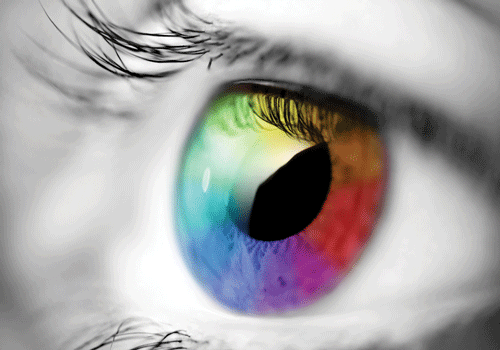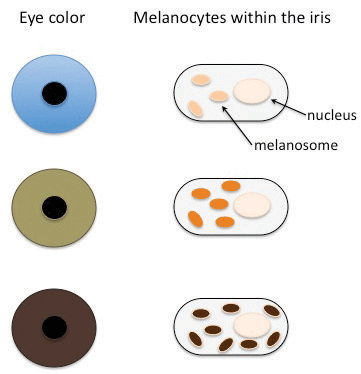Eye Color Eye Color Brown or Blue Punnet Square

Download the PDF version of Biotech Basics: Genetics of Eye Color
Countless students have been taught that a single gene controls eye color, with the allele for brown eyes being dominant over blue. Scientists now realize such a model is overly simplistic and incorrect.
What you need to know:
- DNA provides the set of recipes, or genes, used by cells to carry out daily functions and interact with the environment.
- Eye color was traditionally described as a single gene trait, with brown eyes being dominant over blue eyes.
- Today, scientists have discovered that at least eight genes influence the final color of eyes. The genes control the amount of melanin inside specialized cells of the iris.
- One gene, OCA2, controls nearly three-fourths of the blue-brown color spectrum. However, other genes can override the OCA2 instruction, albeit rarely. This multifactorial model for eye color explains most of the genetic factors that influence eye color.
Introduction
In 1907, Charles and Gertrude Davenport developed a model for the genetics of eye color. They suggested that brown eye color is always dominant over blue eye color. This would mean that two blue-eyed parents would always produce blue-eyed children, never ones with brown eyes.
For most of the past 100 years, this version of eye color genetics has been taught in classrooms around the world. It's one of the few genetic concepts that adults often recall from their high school or college biology classes. Unfortunately, this model is overly simplistic and incorrect – eye color is actually controlled by several genes. Additionally, many of the genes involved in eye color also influence skin and hair tones. In this edition of Biotech Basics, we'll explore the science behind pigmentation and discuss the genetics of eye color. In a future edition, we'll discuss genetic factors that contribute to skin and hair color.
A primer on pigmentation
The color of human eyes, skin and hair is primarily controlled by the amount and type of a pigment called melanin. Specialized cells known as melanocytes produce the melanin, storing it in intracellular compartments known as melanosomes. The overall number of melanocytes is roughly equivalent for all people, however the level of melanin inside each melanosome and the number of melanosomes inside a melanocyte varies. The total amount of melanin is what determines the range of hair, eye and skin colors.
There are a number of genes involved in the production, processing and transport of melanin. Some genes play major roles while others contribute only slightly. To date, scientists have identified over 150 different genes that influence skin, hair and eye pigmentation (an updated list is available at http://www.espcr.org/micemut/). A number of these genes have been identified from studying genetic disorders in humans. Others were discovered through comparative genomic studies of coat color in mice and pigmentation patterns in fish. (A previous Biotech101 article that provides an overview of comparative genomics can be found here.) figure one
Eye color genes
In humans, eye color is determined by the amount of light that reflects off the iris, a muscular structure that controls how much light enters the eye. The range in eye color, from blue to hazel to brown (see figure one), depends on the level of melanin pigment stored in the melanosome  "packets" in the melanocytes of the iris. Blue eyes contain minimal amounts of pigment within a small number of melanosomes. Irises from green–hazel eyes show moderate pigment levels and melanosome number, while brown eyes are the result of high melanin levels stored across many melanosomes (see figure two, left).
"packets" in the melanocytes of the iris. Blue eyes contain minimal amounts of pigment within a small number of melanosomes. Irises from green–hazel eyes show moderate pigment levels and melanosome number, while brown eyes are the result of high melanin levels stored across many melanosomes (see figure two, left).
To date, eight genes have been identified which impact eye color. The OCA2 gene, located on chromosome 15, appears to play a major role in controlling the brown/blue color spectrum. OCA2 produces a protein called P-protein that is involved in the formation and processing of melanin. Individuals with OCA2 mutations that prevent P-protein from being produced are born with a form of albinism. These individuals have very light colored hair, eyes and skin. Non-disease-causing OCA2 variants (alleles) have also been identified. These alleles alter P-protein levels by controlling the amount of OCA2 RNA that is generated. The allele that results in high levels of P-protein is linked to brown eyes. Another allele, associated with blue eye color, dramatically reduces the P-protein concentration.
On the surface, this sounds like the dominant/recessive eye color model that has been taught in biology classes for decades. However, while about three-fourths of eye color variation can be explained by genetic changes in and around this gene, OCA2 is not the only influence on color. A recent study that compared eye color to OCA2 status showed that 62 percent of individuals with two copies of the blue-eyed OCA2 allele, as well as 7.5 percent of the individuals who had the brown-eyed OCA2 alleles, had blue eyes. A number of other genes (such as TYRP1, ASIP and ALC42A5) also function in the melanin pathway and shift the total amount of melanin present in the iris. The combined efforts of these genes may boost melanin levels to produce hazel or brown eyes, or reduce total melanin resulting in blue eyes. This explains how two parents with blue eyes can have green- or brown-eyed children (an impossible situation under the Davenport single gene model) – the combination of color alleles received by the child resulted in a greater amount of melanin than either parent individually possessed.
As a side note, while there is a wide variability in eye color, colors other than brown only exist among individuals of European descent. African and Asian populations are typically brown-eyed. In 2008 a team of researchers studying the OCA2 gene published results demonstrating that the allele associated with blue eyes occurred only within the last 6,000 – 10,000 years within the European population.
Pigmentation research at HudsonAlpha
Dr. Greg Barsh, a physician-scientist who has recently joined the HudsonAlpha faculty, and his lab study key aspects of cell signaling and natural variation as a means to better understand, diagnose and treat human diseases. In particular, his work has focused on pigmentation disorders. He has explored mutations that affect easily observable traits—such as variation in eye, hair or skin colors—as a signpost for more complex processes such as diabetes, obesity, neurodegeneration and melanoma, the most serious form of skin cancer.
– Dr. Neil Lamb
director of educational outreach
HudsonAlpha Institute for Biotechnology
Source: https://www.hudsonalpha.org/the-genetics-of-eye-color/
0 Response to "Eye Color Eye Color Brown or Blue Punnet Square"
Post a Comment